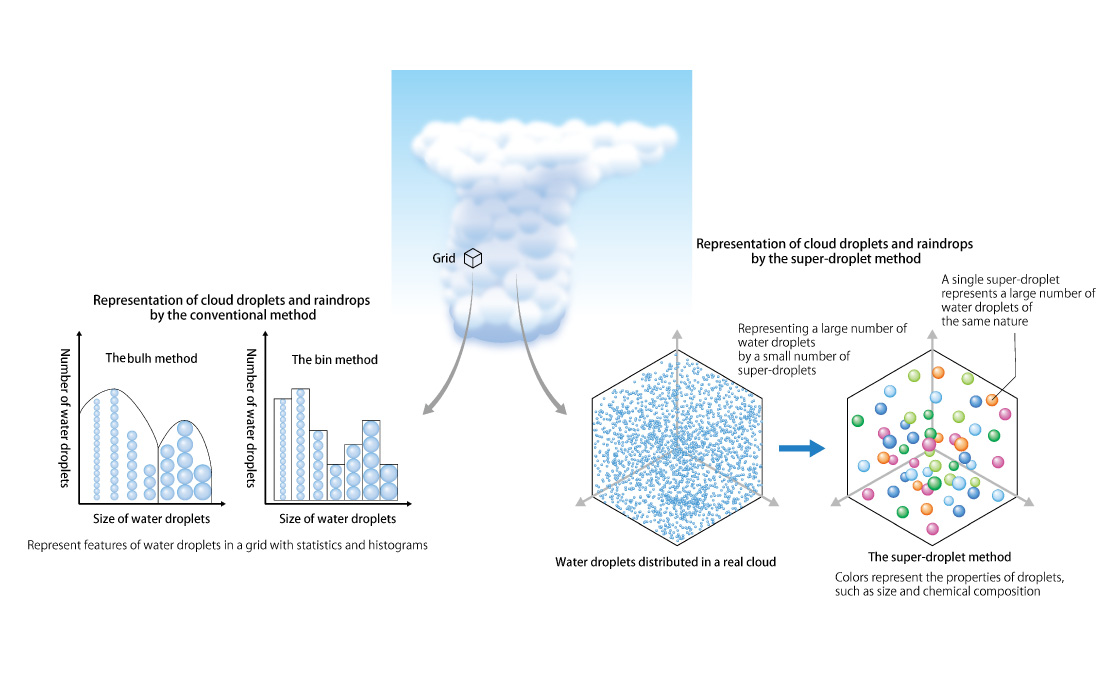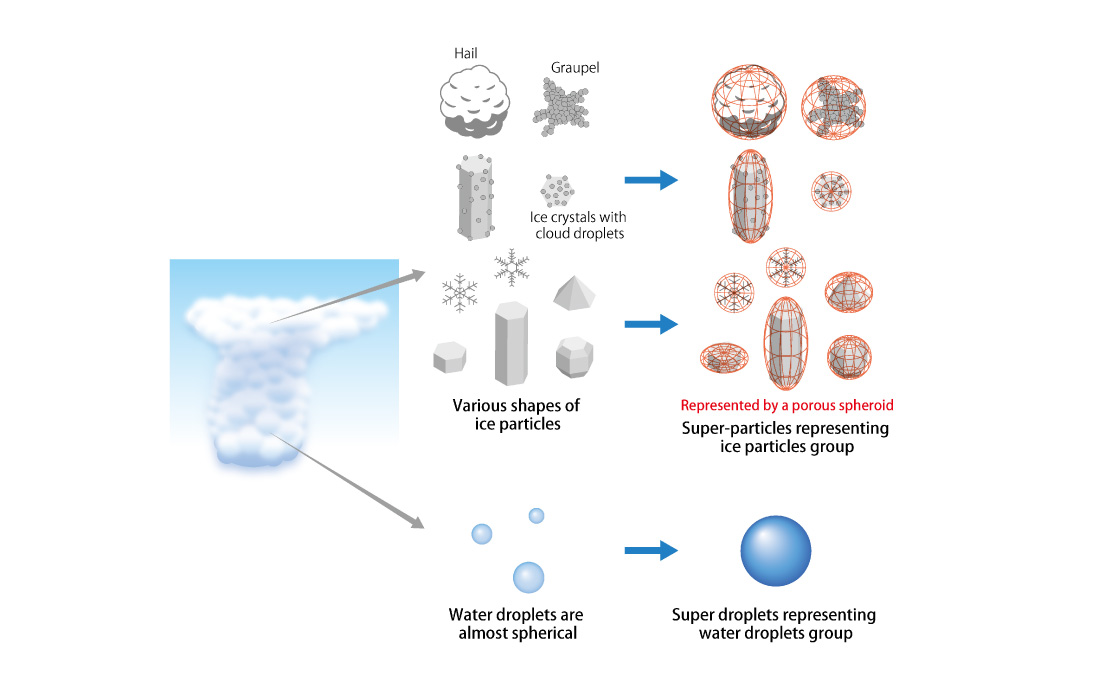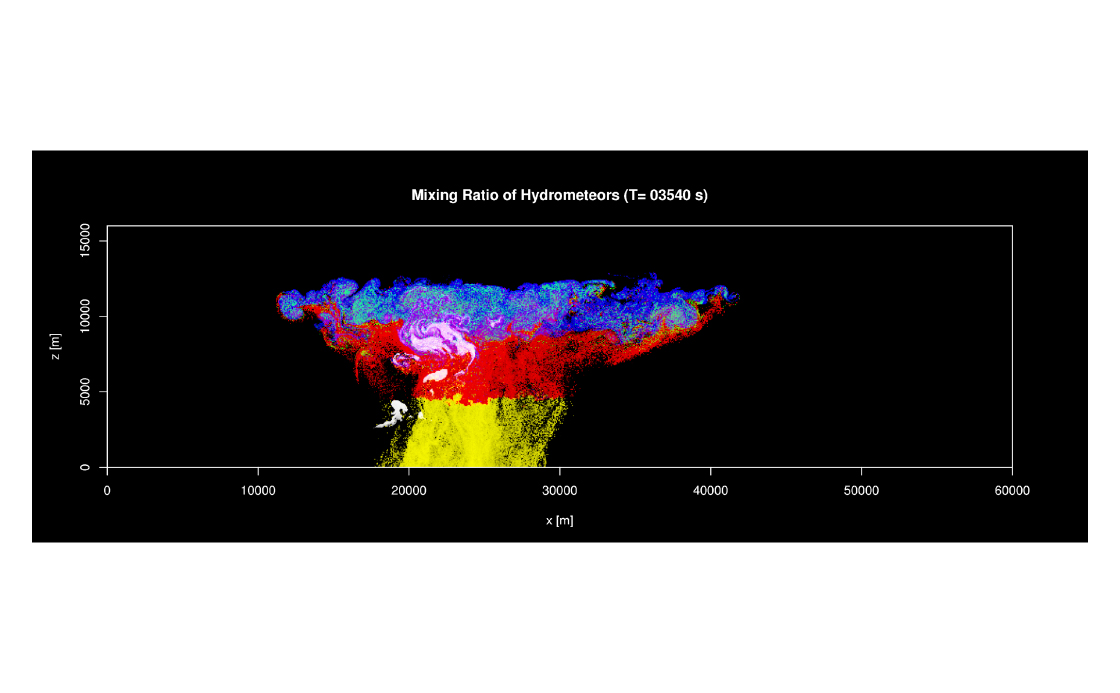Research overview
It remains difficult to accurately represent clouds in numerical models. This limitation is a major source of uncertainty in numerical weather predictions.
Shima et al. (2005) developed a unique computational method called the “super-droplet method,” which has paved the way for reproducing clouds with higher accuracy than conventional methods.
Clouds are collections of tiny water droplets and ice particles.
However, in the original super-droplet method, ice particles are not considered, even though water droplets are well represented, and their behaviors can be accurately calculated. This is because water droplets are approximately spherical, whereas ice particles show a wide variety of shapes.
Shima et al. (2020) improved on the super-droplet method that accurately represents and calculates various ice particles. Clouds containing ice particles are ubiquitous. Even in summer, a large number of ice particles exist in cumulonimbus clouds, from which hailstones may fall.
In this project, the super-droplet method will be used for the first time to simulate extreme weather events that caused severe wind and flood damage in the past, such as cumulonimbus cloud clusters. The results of the project allow for a more accurate simulation of the occurrence and development of cumulonimbus clouds and precipitation than do the conventional methods, thereby contributing to the improvement of probability-estimation accuracy.
Details of research
Aerosols are fine particles suspended in the air, without which cloud formation almost never occurs. Warm clouds are composed of numerous droplets formed by the condensation of water vapor on the surface of the aerosols. In warm clouds, cloud droplets repeatedly collide and coalesce to become larger, eventually generating large drops that fall on the ground surface as rain.
To simulate the formation and development of clouds and precipitation, it is necessary to calculate the movement and diffusional and collisional growth of droplets in clouds based on physical laws. However, clouds contain approximately 100 million cloud droplets per 1 m3. Understanding the behavior of each droplet requires a large amount of computation power. In the future, even if the performance of supercomputer improves significantly, it will be practically impossible to calculate.
Therefore, it is necessary to simplify the calculation of the movement and diffusional/collisional growth of the cloud droplets. Bulk and bin methods are the well-known conventional methods. In the bulk method, the inside of a cloud is divided into grids, and only the statistics of the cloud droplet population, such as the total mass of water in each grid and average particle size, are calculated. In the bin method, which is more detailed, the cloud droplet population in the grid is expressed via a histogram in which the vertical axis represents the number of particles, while the horizontal axis represents the size of the particles. In other words, neither method expresses cloud droplets as particles, making it difficult to accurately calculate the movement and diffusional/collisional growth of the particles.
Shima et al. (2009) developed the “super-droplet method,” in which cloud droplets were represented by computational particles, named super-droplets. The super-droplet method expresses a large number of water droplets with the same characteristics, such as size and chemical composition, as a single super-droplet at a specific position in a cloud. Then, their movement, diffusional growth, and collision-coalescence with other super-droplets are calculated based on physical laws.
If there are similar droplets, we can consider that the result mostly remains unchanged even if they are represented and calculated as one super-droplet. By treating the water droplets in actual clouds as computational particles, the super-droplet method can reproduce the behavior of clouds with higher accuracy than can the conventional bulk and bin methods.
However, even with the super-droplet method, some aspects cannot be properly expressed. As the air temperature decreases with increasing altitude, water droplets in the clouds become ice particles.
Because the shape of atmospheric water droplets is almost spherical, water droplets can be simply expressed by their size. However, atmospheric ice particles have various shapes. For example, snow crystals are dendritic or needle-shaped, whereas graupel particles and hailstones are round. In addition, the density of ice particles greatly varies from many pores to tightly packed ones. Because the original super-droplet method targets water droplets, it cannot express various ice particles and cannot be used to calculate clouds containing ice particles.
Cumulonimbus clouds intensively develop, can reach more than 10 km, and contain many ice particles. Ice particles fall at different speeds, depending on their shape, the way they collide and coalesce, and the manner in which they melt. The formation of large and heavy ice particles leads to increased precipitation. To reproduce the behavior of cumulonimbus clouds and determine the amount of precipitation, it is necessary to accurately represent various ice particles in the model.
Shima et al. (2020) simplified the various shapes of ice particles with porous spheroidal “super-particles.” The outer shape of ice particles can be expressed by deforming the spheroids. The difference in density indicates the difference in the internal structure of ice particles, such as dendritic or plate-like. They also considered the amount of aerosol components contained in each ice particle or water droplet. In this way, Shima et al. (2020) improved on the super-droplet method so as to quantify the movement, diffusional growth, and collision-coalescence of ice particles.
If the history of how ice particles collide and coalesce is known, the properties of ice particles can be estimated more accurately. If the particles are charged with positive or negative electricity, the probability of collision and coalescence and the shape of the resultant ice particles become different. In the future, we plan on adding more detailed features to super-droplets, such as the history and electrification of ice particles. It is virtually impossible to calculate such detailed features of ice particles by using the bulk or bin methods, which undermine the true nature of various clouds.
Figure 3 shows the simulation of cumulonimbus cloud based on the improved version of the super-droplet method. It presents small ice crystals in blue, graupels and hailstones in red, snow aggregates in green, and raindrops in yellow.
The simulation shown in Figure 3 is an “ideal experiment” that simulates cumulonimbus clouds under simplified conditions that are easier to calculate. In reality, for example, the topography of the ground surface is uneven, and cities and forests are spread out; however, in this “ideal experiment”, calculations are performed under the simplified assumptions, such as a flat sea surface.
This project is first to conduct a “real atmospheric experiment” under realistic conditions based on the super-droplet method. A “real atmospheric experiment” calculates a wider area over a longer period than an “ideal experiment”. As the amount of computation increases, the grid size grows, and the resolution becomes coarser.
In the super-droplet method, it is necessary to consider that the super-droplets and super-particles flow from outside the simulation area. In the “ideal experiment”, simple periodic conditions are also set for the inflow method; however, in the “real atmospheric experiment”, it is necessary to set realistic and complicated conditions.
Thus, the conditions and settings greatly differ between the “ideal experiment” and the “real atmospheric experiment”. In other words, it is unknown what kind of cumulonimbus cloud will be reproduced based on the improved version of the super-droplet method. In addition, the current super-droplet method does not consider the splitting of water droplets and ice particles, which would affect the precipitation amount of the cumulonimbus clouds.
In this project, the simulation results are compared with the features and behaviors of water droplets and ice particles in actual cumulonimbus clouds based on data obtained from aircraft, balloons, and new radars, so as to validate and improve the super-droplet method.
Next will be the simulations of past events of severe weather, such as cloud clusters with heavy rain, based on the super-droplet method. We aim to demonstrate that the super-droplet method is more accurate than the conventional method in terms of reproducing the formation and development of cumulonimbus clouds and precipitation. This will in turn contribute to the development of weather models to ensure the most accurate probability estimation.





